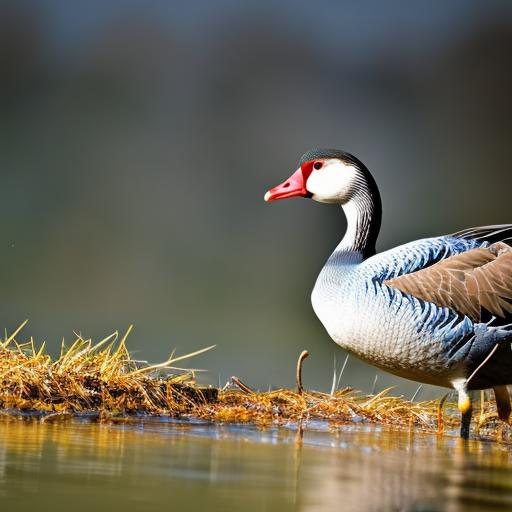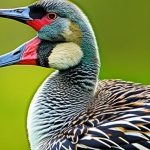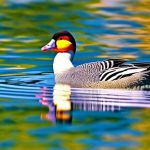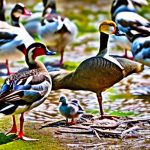Geese can be beautiful creatures to observe in their natural habitat, but when they invade our properties, they can cause damage and pose health risks. Geese are known for their droppings, which can be unsightly and difficult to clean up. They can also damage lawns, gardens, and crops with their feeding habits. In addition, geese can carry diseases such as avian influenza and salmonella, which can be transmitted to humans. Therefore, it is important to find humane ways to deter geese from our properties and keep them at a safe distance.
Key Takeaways
- Physical barriers like fencing and netting can be effective in keeping geese away.
- Visual deterrents such as scarecrows, decoys, and reflective tape can also discourage geese.
- Auditory deterrents like noise-making devices and predator calls can be used to scare geese away.
- Taste repellents like chemical sprays and natural remedies can make the area unappealing to geese.
- Habitat modification, motion-activated sprinklers, ultrasonic devices, and professional services can also help manage geese populations.
Physical barriers: Fencing and netting options
One effective way to keep geese away from certain areas is by installing physical barriers such as fences or netting. Fences can be made of various materials such as metal, wood, or plastic and should be at least three feet high to prevent geese from easily crossing over. Netting can be used to cover ponds or other bodies of water to prevent geese from accessing them.
When choosing fencing or netting options, it is important to consider the specific needs of your property. For example, if you have a large area that needs protection, electric fencing may be a more effective option. Electric fencing delivers a mild shock to geese when they come into contact with it, deterring them from attempting to cross over.
Visual deterrents: Scarecrows, decoys, and reflective tape
Visual deterrents can trick geese into thinking there is a predator nearby, causing them to avoid certain areas. Scarecrows and decoys that resemble natural predators such as coyotes or owls can be effective in scaring geese away. These visual deterrents should be moved periodically to maintain their effectiveness.
Another visual deterrent that can be used is reflective tape. When hung in strips or tied around trees or poles, reflective tape creates a visual disturbance that scares geese away. The movement and reflection of light can make geese feel uncomfortable and unsafe, causing them to avoid the area.
Auditory deterrents: Noise-making devices and predator calls
Auditory deterrents can startle geese and make them feel unsafe, causing them to leave the area. Noise-making devices such as air horns or whistles can be effective in scaring geese away. These devices should be used sparingly and strategically to maintain their effectiveness.
Another auditory deterrent that can be used is predator calls. These calls mimic the sounds of natural predators such as foxes or hawks, causing geese to believe that there is a threat nearby. Predator calls can be played through speakers or recorded and played on a loop.
Taste repellents: Chemical sprays and natural remedies
Taste repellents can be used to make grass and other vegetation taste bad to geese, discouraging them from feeding in certain areas. Chemical sprays can be applied to lawns, gardens, or crops to make them unappetizing to geese. These sprays are typically safe for humans and pets but should be used according to the manufacturer’s instructions.
Natural remedies can also be effective in deterring geese. Garlic or hot pepper can be sprinkled on grass or vegetation to make it taste unpleasant to geese. These natural remedies are safe for humans and pets but should be used in moderation.
Habitat modification: Altering the environment to discourage geese

Modifying the habitat can make an area less attractive to geese, discouraging them from staying in the area. Removing sources of food and water, such as bird feeders or standing water, can help deter geese from your property. Additionally, planting certain types of vegetation that geese do not prefer can make an area less appealing to them.
For example, geese prefer short grasses and open spaces where they can easily spot predators. Planting taller grasses or shrubs can make an area less attractive to geese. Additionally, planting vegetation that geese do not like to eat, such as prickly or thorny plants, can also help deter them.
Motion-activated sprinklers: Water-based deterrents
Motion-activated sprinklers can startle geese and make them uncomfortable, causing them to avoid certain areas. These sprinklers are equipped with motion sensors that detect the presence of geese and activate a burst of water. The sudden spray of water surprises and scares geese, making them feel unsafe.
In addition to deterring geese, motion-activated sprinklers can also help keep lawns and other areas free of geese droppings. The constant movement and noise of the sprinklers can discourage geese from staying in the area.
Ultrasonic devices: High-frequency sound waves to deter geese
Ultrasonic devices emit high-frequency sound waves that are unpleasant for geese but inaudible to humans. These devices can be placed in areas where geese are a problem and emit a continuous or intermittent sound that deters geese from staying in the area.
Ultrasonic devices are effective in keeping geese away from certain areas but should be used in conjunction with other deterrent methods for maximum effectiveness. It is important to note that ultrasonic devices may not work on all species of geese, as some may become accustomed to the sound over time.
Professional services: Hiring trained professionals to manage geese populations
If you are dealing with a large population of geese or have tried various deterrent methods without success, it may be beneficial to hire trained professionals to manage the geese population. These professionals have experience in using a variety of methods to deter geese and can provide advice on how to prevent geese from becoming a problem in the first place.
Professional services may include habitat modification, population management, and ongoing maintenance to ensure that geese do not return to the area. They can also provide guidance on legal and ethical considerations when dealing with geese populations.
Preventive measures: Tips for preventing geese from becoming a problem in the first place
Preventing geese from becoming a problem in the first place is often easier and more effective than trying to manage an existing population. Here are some preventive measures you can take:
1. Remove sources of food and water: Geese are attracted to areas with abundant food and water sources. By removing bird feeders, pet food, and standing water, you can discourage geese from staying in your area.
2. Plant certain types of vegetation: As mentioned earlier, planting taller grasses or shrubs can make an area less attractive to geese. Additionally, planting vegetation that geese do not like to eat can help deter them.
3. Use physical barriers: Installing fences or netting can prevent geese from accessing certain areas. By creating physical barriers, you can effectively keep geese away from your property.
4. Be proactive in managing geese populations: Regularly monitor your property for signs of geese and take action before they become a problem. By being proactive, you can prevent geese from establishing a presence on your property.
In conclusion, there are many humane ways to deter geese from causing damage and posing health risks. By using a combination of physical barriers, visual and auditory deterrents, taste repellents, habitat modification, motion-activated sprinklers, ultrasonic devices, and professional services, you can effectively manage geese populations and prevent them from becoming a problem in the first place. It is important to choose the methods that are most suitable for your specific needs and to use them consistently for optimal results.
If you’re looking for effective ways to keep geese away, you might also be interested in learning about the benefits of converting a shed into a chicken coop. This article from Poultry Wizard explores the process of transforming a shed into a suitable living space for your chickens, providing valuable insights and tips. By creating a secure and comfortable environment for your feathered friends, you can not only keep them safe but also deter geese from encroaching on their territory. Check out the article here to discover how you can repurpose a shed into a functional chicken coop.
FAQs
What are some effective ways to keep geese away?
There are several effective ways to keep geese away, including using decoys, installing fencing, using repellents, and modifying the landscape.
What are some natural repellents that can be used to keep geese away?
Some natural repellents that can be used to keep geese away include grape concentrate, garlic, and hot pepper.
What are some non-lethal methods of keeping geese away?
Non-lethal methods of keeping geese away include using noise deterrents, visual deterrents, and physical barriers.
What are some physical barriers that can be used to keep geese away?
Physical barriers that can be used to keep geese away include fencing, netting, and bird spikes.
What are some noise deterrents that can be used to keep geese away?
Noise deterrents that can be used to keep geese away include propane cannons, air horns, and electronic devices that emit distress calls.
What are some visual deterrents that can be used to keep geese away?
Visual deterrents that can be used to keep geese away include decoys, scarecrows, and reflective tape.
What are some reasons why geese may be attracted to a particular area?
Geese may be attracted to a particular area because of the presence of water, food sources, and suitable nesting sites.
Meet Walter, the feathered-friend fanatic of Florida! Nestled in the sunshine state, Walter struts through life with his feathered companions, clucking his way to happiness. With a coop that’s fancier than a five-star hotel, he’s the Don Juan of the chicken world. When he’s not teaching his hens to do the cha-cha, you’ll find him in a heated debate with his prized rooster, Sir Clucks-a-Lot. Walter’s poultry passion is no yolk; he’s the sunny-side-up guy you never knew you needed in your flock of friends!







